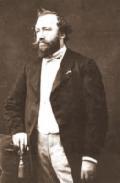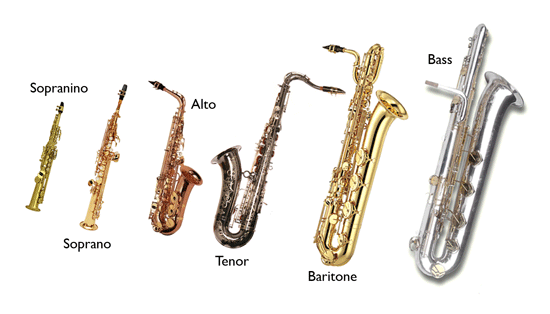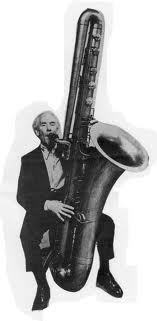Adolphe Sax
Antoine-Joseph 'Adolphe' Sax (November 6, 1814 – February 4, 1894) was a Belgian musical instrument designer and musician (clarinetist),best known for inventing the saxophone.
Adolphe Sax was born in Dinant in Wallonia, Belgium. His father, Charles-Joseph Sax, was an instrument designer himself, who made several changes to the design of the horn. Adolphe began to make his own instruments at an early age, entering two of his flutes and a clarinet into a competition at the age of fifteen. He subsequently studied those two instruments at the Royal School of Singing in Brussels.
Having left the school, Sax began to experiment with new instrument designs, while his father continued to produce conventional instruments to bring money into the household. Adolphe's first important invention was an improvement of the bass clarinet design which he patented at the age of twenty.
In 1841, Sax relocated permanently to Paris and began work on a new set of instruments which were exhibited there in 1844. They were valved bugles, and although he had not invented the instrument itself, his examples were so much more successful than those of his rivals that they became known as saxhorns. They range in approximately seven different sizes, and paved the path to the creation of the flugelhorn. Today, they are widely used in concert bands and sometimes in orchestras. The saxhorn also laid the groundwork for the modern euphonium.
Sax also developed the saxotromba family, valved brass instruments with narrower bore than the saxhorns, in 1845, though they survived only briefly. Saxhorn instruments spread rapidly throughout the world. The saxhorn valves were accepted as state of the art and are still largely unchanged today. The advances made by Adolphe Sax were soon followed by the formation of the famous British brass band movement which exclusively adopted the saxhorn range. An example is the Jedforest Instrumental Band which formed in 1854 within the Scottish Borders only a decade after saxhorn models became available.
The period around 1840 saw Sax inventing the clarinette-bourdon, an early (and unsuccessful) design of contrabass clarinet. Most significantly, at this time he developed the instrument for which he is now best known, the saxophone, patented in 1846. The saxophone was invented for use in both orchestras and concert bands. The composer Hector Berlioz wrote approvingly of the new instrument in 1842. By 1846 Sax had designed, on paper at least, a full range of saxophones (from sopranino to subcontrabass). Although they never became standard orchestral instruments, the saxophones made his reputation, and secured him a job teaching at the Paris Conservatoire from 1867.
Sax continued to make instruments later in life, as well as presiding over a new saxophone class at the Paris Conservatoire. However, rival instrument makers attacked the legitimacy of his patents and mounted a long campaign of litigation against Sax and his company, driving him into bankruptcy twice (in 1856 and 1873).
Sax suffered from lip cancer between 1853 and 1858 but made a full recovery. He died in 1894 in Paris (largely penniless after spending much of his later life defending his many patents) and was interred in section 5 (Avenue de Montebello) at the Cimetière de Montmartre in Paris.

The Saxophone Family

Most saxophones look like a ‘J’ - the stereotypical sax shape. The exceptions to this are the soprano and sopranino saxes (although the soprano sax is also made in the 'J' shape). The straight horns lend themselves much better to the higher register.
The keys of a saxophone consist of metal disks with leather pads under them to seal the openings in the body of the instrument. On first inspection, the saxophone mechanism looks exceptionally complex. However, the fingering of a saxophone is relatively straightforward. The fingering is very similar to that of a recorder, flute, oboe or clarinet. For those of you who played the recorder at the age of seven, start casting your mind back! The mechanism was invented by the German instrument maker Theobald Boehm (hence the Boehm mechanism),a contemporary of Adolphe Sax.
Sopranino (E-flat)
Also doubling as a sheep dog training aid, the sopranino saxophone plays an octave above the alto sax. It's a tiny horn, and is made in both straight and curved designs. I’ve never seen one, let alone played one, and in any case, I wouldn’t want to put my pet pooches through such trauma!
Soprano (B-flat)
The soprano sax is a relatively small horn and more resembles a clarinet in size. Most sopranos are straight, although curved sopranos do exist (I can’t help thinking about Sherlock Holmes’ pipe when I see a curved soprano!) It’s tricky to find a good soprano sax and they are more difficult than their alto and tenor cousins to play well.
Alto (E-flat)
Probably the most common horn of the sax family and generally regarded as the easiest of the saxophone range to play, it’s a good horn to start learning on. Alto horns are comfortable to hold, relatively easy to blow and (as far as saxes go) reasonably priced.
Tenor (B-flat)
This is the sax typically played by jazz and rock players. You can differentiate between alto and tenor saxes by the shapes of their necks. An alto sax has an L-shaped neck with a slight bend. A tenor sax neck is more like a swan neck with a distinctive curve. A tenor horn larger and heavier than an alto.
Baritone (E-flat)
The baritone sax plays an octave below the alto saxophone and is big. And heavy! It requires a serious set of lungs and pretty substantial neck and shoulder muscles to play for more than 20 minutes! It's bigger again than a tenor sax and has a neck that's curled round into a loop.
Bass (B-flat)
You can get floor supports for the bass sax — attempting to support one of these things with a neck strap would probably require a month of traction at the end of your set. Daily practice blowing up lorry tyres will be a great training aid in learning to play one of these instruments. There are portable bass horns — the Selmer Model 56, for example — but you'll almost certainly want to press weights for a few weeks before you undertake playing one for a long period.
Contrabass (E-flat)
The contrabass sax usually lives on an adjustable wheeled base. It has to because it is ‘huge’. At about 2m high, you can’t take this horn to your local pub gig in your Corsa. And after shelling out around £20,000 for one of these you won’t have any cash left to buy a car anyway! I s’pose if you are lucky enough to own a contrabass, you’ll at least have a decent six-pack!
Sub Contrabass (B-flat)
What more can I say!
I'm not sure how many of these there are in the country but I'd guess the number is probably more than two and less than four!
The sax as a transposing instrument
You may have noticed all the E-flats and B-flats in the titles above. This is because the saxophone is a transposing instrument. When an alto sax plays a C, it sounds like an E-flat on a piano. Similarly, when a tenor sax plays a C, it sounds like a B-flat on a piano. The reason for this is not immediately apparent, but is thought to be due to the quality of the sound/pitch relating to the size of each horn, along with the requirement to fit in better with the already established brass instruments in marching bands. Whatever the reason (and this is another subject altogether),when playing along with other people, you'll be in a different key to them. Somewhat frustrating, but that's the way it is!
So why wasn't the sax made in the key of C?
Well, it was.But it wasn't very good, and not many were ever made!
It was called the C melody saxophone and appeared in the United States during the 1920s and 1930s during the great depression. But for several reasons they didn't take off (one reason being that their tuning was particularly bad). These days they do come up for sale and are not that expensive. But, with the absence of spare parts for them, they wouldn't be a great investment.

Saxophone costs
As you can imagine, the costs for any sax are wide, but unfortunately, not small. To give you some idea, a good student alto will cost £300 upwards for a new one. Second hand altos start around £200. A new professional alto will cost from £1000 upwards.
Most good music shops offer a service whereby you can rent a new horn for £20 per month for three or six months. Should you then decide to buy the sax, they will normally deduct the rental cost from the new price.
ebay
A quick word about the cheap saxes on ebay from the Far East - great for hanging on the wall...need I say more?
Having said that, there are many good horns to be had on ebay, but BE CAREFUL! Always speak to the seller, find out the serial number to check the year of manufacture, get photos sent to you to study and if in any doubt whatsoever, walk away - there are plenty out there.